engine FIAT DOBLO COMBI 2018 Owner handbook (in English)
[x] Cancel search | Manufacturer: FIAT, Model Year: 2018, Model line: DOBLO COMBI, Model: FIAT DOBLO COMBI 2018Pages: 272, PDF Size: 23.75 MB
Page 161 of 272
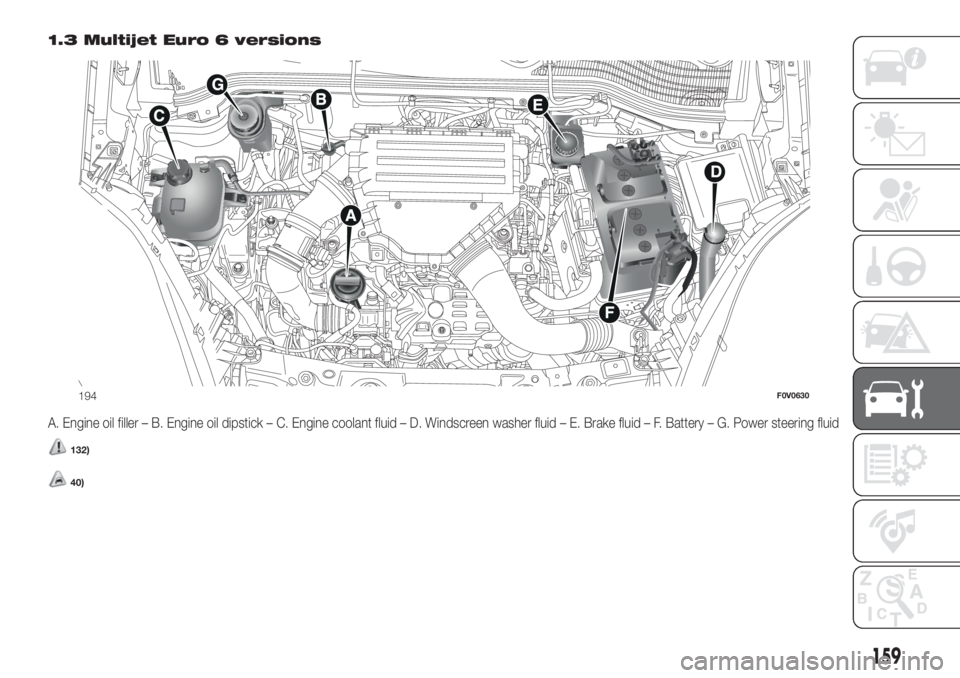
1.3 Multijet Euro 6 versions
A. Engine oil filler – B. Engine oil dipstick – C. Engine coolant fluid – D. Windscreen washer fluid – E. Brake fluid – F. Battery – G. Power steering fluid
132)
40)
194F0V0630
159
Page 162 of 272
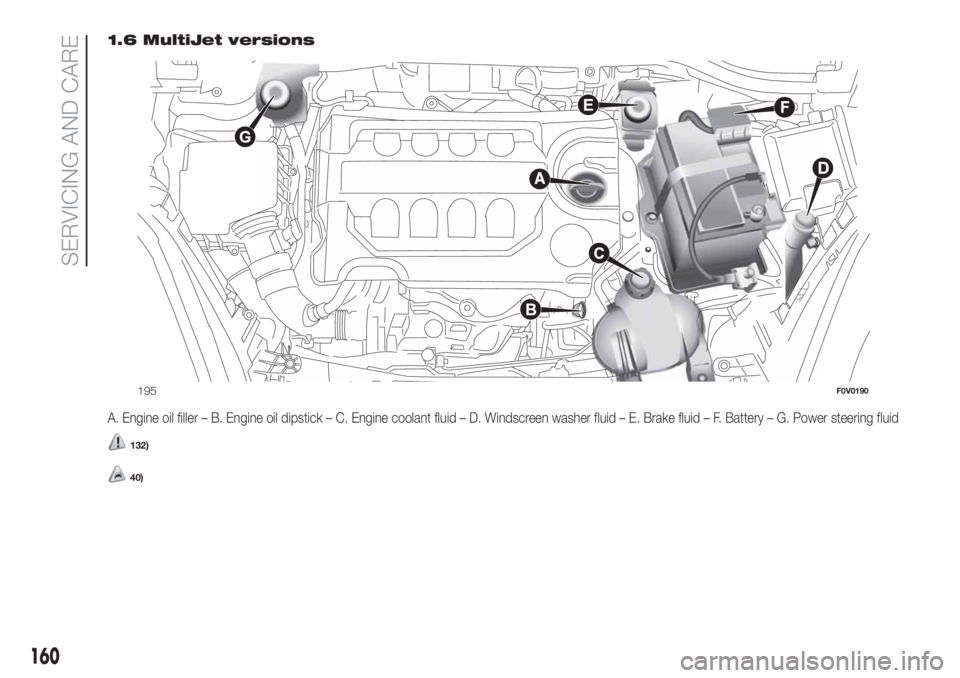
1.6 MultiJet versions
A. Engine oil filler – B. Engine oil dipstick – C. Engine coolant fluid – D. Windscreen washer fluid – E. Brake fluid – F. Battery – G. Power steering fluid
132)
40)
195F0V0190
160
SERVICING AND CARE
Page 163 of 272
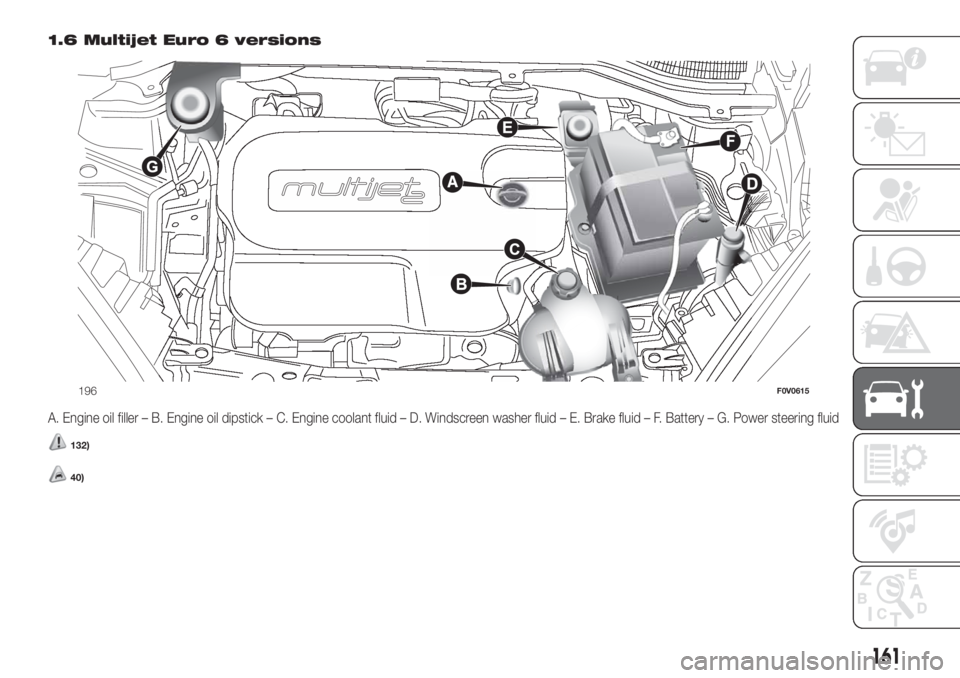
1.6 Multijet Euro 6 versions
A. Engine oil filler – B. Engine oil dipstick – C. Engine coolant fluid – D. Windscreen washer fluid – E. Brake fluid – F. Battery – G. Power steering fluid
132)
40)
196F0V0615
161
Page 164 of 272
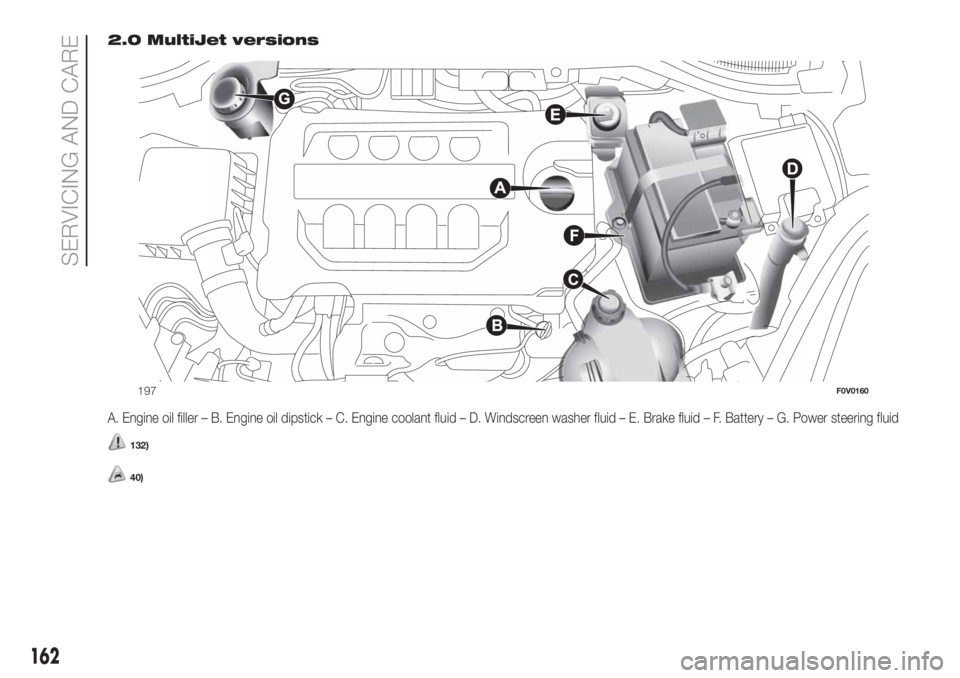
2.0 MultiJet versions
A. Engine oil filler – B. Engine oil dipstick – C. Engine coolant fluid – D. Windscreen washer fluid – E. Brake fluid – F. Battery – G. Power steering fluid
132)
40)
197F0V0160
162
SERVICING AND CARE
Page 165 of 272
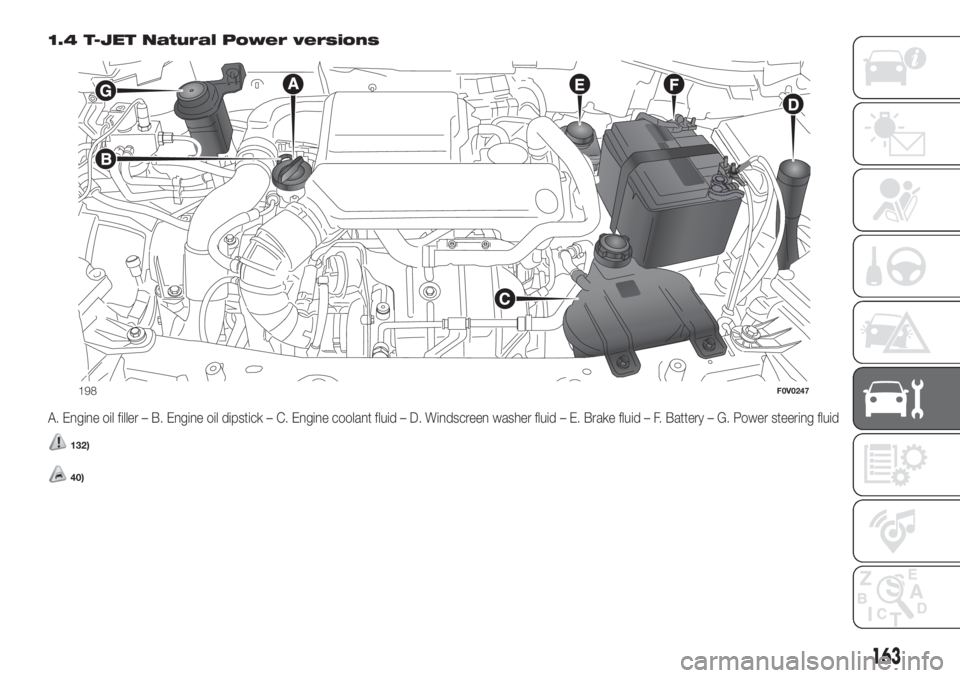
1.4 T-JET Natural Power versions
A. Engine oil filler – B. Engine oil dipstick – C. Engine coolant fluid – D. Windscreen washer fluid – E. Brake fluid – F. Battery – G. Power steering fluid
132)
40)
198F0V0247
163
Page 166 of 272
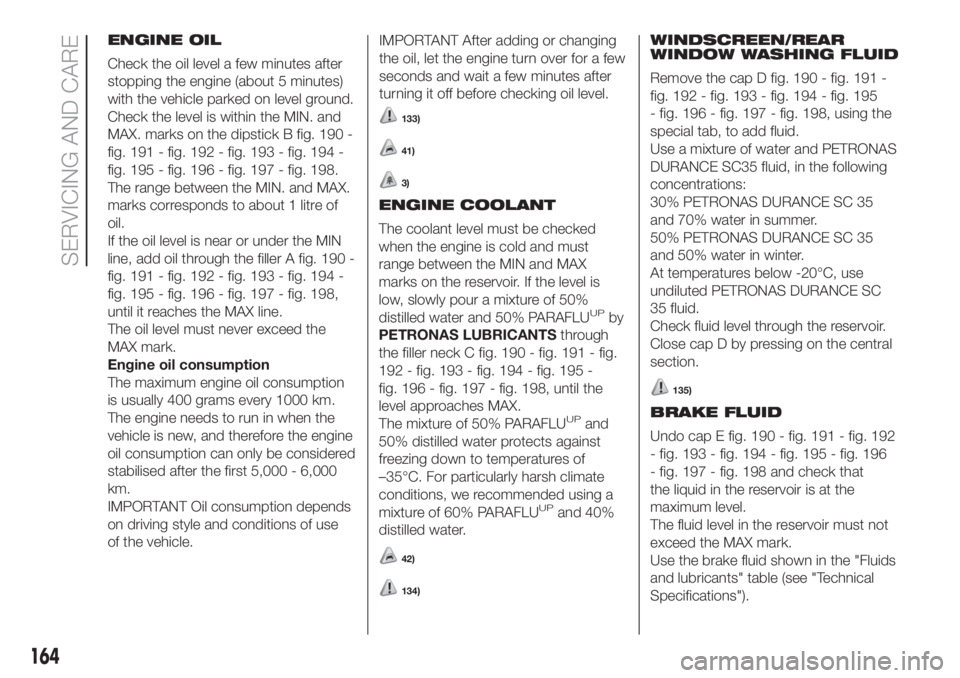
ENGINE OIL
Check the oil level a few minutes after
stopping the engine (about 5 minutes)
with the vehicle parked on level ground.
Check the level is within the MIN. and
MAX. marks on the dipstick B fig. 190 -
fig. 191 - fig. 192 - fig. 193 - fig. 194 -
fig. 195 - fig. 196 - fig. 197 - fig. 198.
The range between the MIN. and MAX.
marks corresponds to about 1 litre of
oil.
If the oil level is near or under the MIN
line, add oil through the filler A fig. 190 -
fig. 191 - fig. 192 - fig. 193 - fig. 194 -
fig. 195 - fig. 196 - fig. 197 - fig. 198,
until it reaches the MAX line.
The oil level must never exceed the
MAX mark.
Engine oil consumption
The maximum engine oil consumption
is usually 400 grams every 1000 km.
The engine needs to run in when the
vehicle is new, and therefore the engine
oil consumption can only be considered
stabilised after the first 5,000 - 6,000
km.
IMPORTANT Oil consumption depends
on driving style and conditions of use
of the vehicle.IMPORTANT After adding or changing
the oil, let the engine turn over for a few
seconds and wait a few minutes after
turning it off before checking oil level.
133)
41)
3)
ENGINE COOLANT
The coolant level must be checked
when the engine is cold and must
range between the MIN and MAX
marks on the reservoir. If the level is
low, slowly pour a mixture of 50%
distilled water and 50% PARAFLU
UPby
PETRONAS LUBRICANTSthrough
the filler neck C fig. 190 - fig. 191 - fig.
192 - fig. 193 - fig. 194 - fig. 195 -
fig. 196 - fig. 197 - fig. 198, until the
level approaches MAX.
The mixture of 50% PARAFLU
UPand
50% distilled water protects against
freezing down to temperatures of
–35°C. For particularly harsh climate
conditions, we recommended using a
mixture of 60% PARAFLU
UPand 40%
distilled water.
42)
134)
WINDSCREEN/REAR
WINDOW WASHING FLUID
Remove the cap D fig. 190 - fig. 191 -
fig. 192 - fig. 193 - fig. 194 - fig. 195
- fig. 196 - fig. 197 - fig. 198, using the
special tab, to add fluid.
Use a mixture of water and PETRONAS
DURANCE SC35 fluid, in the following
concentrations:
30% PETRONAS DURANCE SC 35
and 70% water in summer.
50% PETRONAS DURANCE SC 35
and 50% water in winter.
At temperatures below -20°C, use
undiluted PETRONAS DURANCE SC
35 fluid.
Check fluid level through the reservoir.
Close cap D by pressing on the central
section.
135)
BRAKE FLUID
Undo cap E fig. 190 - fig. 191 - fig. 192
- fig. 193 - fig. 194 - fig. 195 - fig. 196
- fig. 197 - fig. 198 and check that
the liquid in the reservoir is at the
maximum level.
The fluid level in the reservoir must not
exceed the MAX mark.
Use the brake fluid shown in the "Fluids
and lubricants" table (see "Technical
Specifications").
164
SERVICING AND CARE
Page 167 of 272
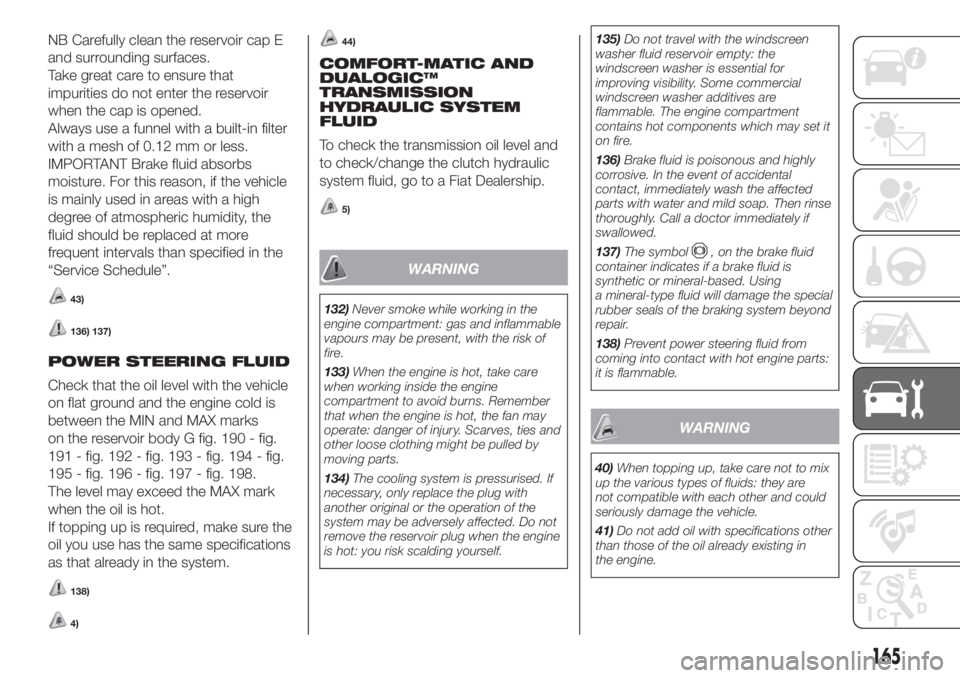
NB Carefully clean the reservoir cap E
and surrounding surfaces.
Take great care to ensure that
impurities do not enter the reservoir
when the cap is opened.
Always use a funnel with a built-in filter
with a mesh of 0.12 mm or less.
IMPORTANT Brake fluid absorbs
moisture. For this reason, if the vehicle
is mainly used in areas with a high
degree of atmospheric humidity, the
fluid should be replaced at more
frequent intervals than specified in the
“Service Schedule”.
43)
136) 137)
POWER STEERING FLUID
Check that the oil level with the vehicle
on flat ground and the engine cold is
between the MIN and MAX marks
on the reservoir body G fig. 190 - fig.
191 - fig. 192 - fig. 193 - fig. 194 - fig.
195 - fig. 196 - fig. 197 - fig. 198.
The level may exceed the MAX mark
when the oil is hot.
If topping up is required, make sure the
oil you use has the same specifications
as that already in the system.
138)
4)
44)
COMFORT-MATIC AND
DUALOGIC™
TRANSMISSION
HYDRAULIC SYSTEM
FLUID
To check the transmission oil level and
to check/change the clutch hydraulic
system fluid, go to a Fiat Dealership.
5)
WARNING
132)Never smoke while working in the
engine compartment: gas and inflammable
vapours may be present, with the risk of
fire.
133)When the engine is hot, take care
when working inside the engine
compartment to avoid burns. Remember
that when the engine is hot, the fan may
operate: danger of injury. Scarves, ties and
other loose clothing might be pulled by
moving parts.
134)The cooling system is pressurised. If
necessary, only replace the plug with
another original or the operation of the
system may be adversely affected. Do not
remove the reservoir plug when the engine
is hot: you risk scalding yourself.135)Do not travel with the windscreen
washer fluid reservoir empty: the
windscreen washer is essential for
improving visibility. Some commercial
windscreen washer additives are
flammable. The engine compartment
contains hot components which may set it
on fire.
136)Brake fluid is poisonous and highly
corrosive. In the event of accidental
contact, immediately wash the affected
parts with water and mild soap. Then rinse
thoroughly. Call a doctor immediately if
swallowed.
137)The symbol
, on the brake fluid
container indicates if a brake fluid is
synthetic or mineralbased. Using
a mineral-type fluid will damage the special
rubber seals of the braking system beyond
repair.
138)Prevent power steering fluid from
coming into contact with hot engine parts:
it is flammable.
WARNING
40)When topping up, take care not to mix
up the various types of fluids: they are
not compatible with each other and could
seriously damage the vehicle.
41)Do not add oil with specifications other
than those of the oil already existing in
the engine.
165
Page 168 of 272
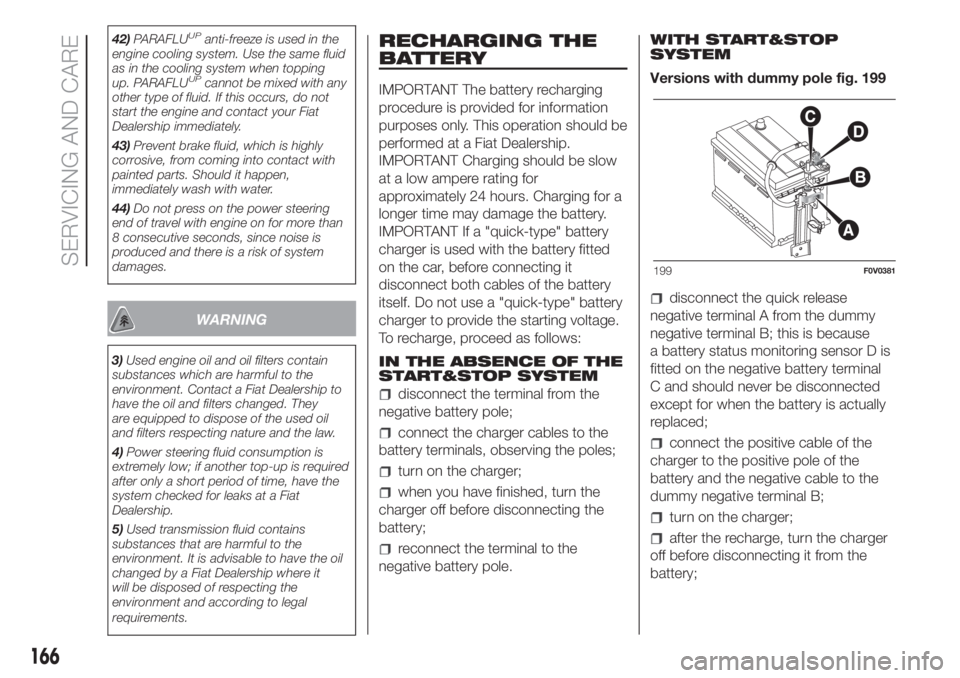
42)PARAFLUUPanti-freeze is used in the
engine cooling system. Use the same fluid
as in the cooling system when topping
up. PARAFLU
UPcannot be mixed with any
other type of fluid. If this occurs, do not
start the engine and contact your Fiat
Dealership immediately.
43)Prevent brake fluid, which is highly
corrosive, from coming into contact with
painted parts. Should it happen,
immediately wash with water.
44)Do not press on the power steering
end of travel with engine on for more than
8 consecutive seconds, since noise is
produced and there is a risk of system
damages.
WARNING
3)Used engine oil and oil filters contain
substances which are harmful to the
environment. Contact a Fiat Dealership to
have the oil and filters changed. They
are equipped to dispose of the used oil
and filters respecting nature and the law.
4)Power steering fluid consumption is
extremely low; if another top-up is required
after only a short period of time, have the
system checked for leaks at a Fiat
Dealership.
5)Used transmission fluid contains
substances that are harmful to the
environment. It is advisable to have the oil
changed by a Fiat Dealership where it
will be disposed of respecting the
environment and according to legal
requirements.
RECHARGING THE
BATTERY
IMPORTANT The battery recharging
procedure is provided for information
purposes only. This operation should be
performed at a Fiat Dealership.
IMPORTANT Charging should be slow
at a low ampere rating for
approximately 24 hours. Charging for a
longer time may damage the battery.
IMPORTANT If a "quick-type" battery
charger is used with the battery fitted
on the car, before connecting it
disconnect both cables of the battery
itself. Do not use a "quick-type" battery
charger to provide the starting voltage.
To recharge, proceed as follows:
IN THE ABSENCE OF THE
START&STOP SYSTEM
disconnect the terminal from the
negative battery pole;
connect the charger cables to the
battery terminals, observing the poles;
turn on the charger;
when you have finished, turn the
charger off before disconnecting the
battery;
reconnect the terminal to the
negative battery pole.WITH START&STOP
SYSTEM
Versions with dummy pole fig. 199
disconnect the quick release
negative terminal A from the dummy
negative terminal B; this is because
a battery status monitoring sensor D is
fitted on the negative battery terminal
C and should never be disconnected
except for when the battery is actually
replaced;
connect the positive cable of the
charger to the positive pole of the
battery and the negative cable to the
dummy negative terminal B;
turn on the charger;
after the recharge, turn the charger
off before disconnecting it from the
battery;
199F0V0381
166
SERVICING AND CARE
Page 172 of 272
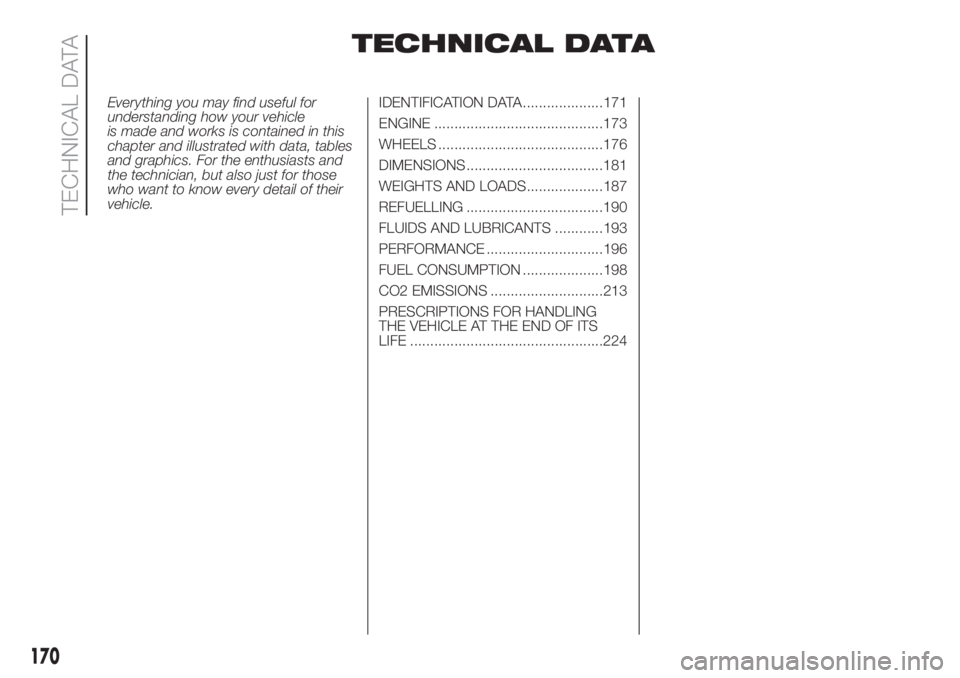
TECHNICAL DATA
Everything you may find useful for
understanding how your vehicle
is made and works is contained in this
chapter and illustrated with data, tables
and graphics. For the enthusiasts and
the technician, but also just for those
who want to know every detail of their
vehicle.IDENTIFICATION DATA....................171
ENGINE ..........................................173
WHEELS .........................................176
DIMENSIONS ..................................181
WEIGHTS AND LOADS...................187
REFUELLING ..................................190
FLUIDS AND LUBRICANTS ............193
PERFORMANCE .............................196
FUEL CONSUMPTION ....................198
CO2 EMISSIONS ............................213
PRESCRIPTIONS FOR HANDLING
THE VEHICLE AT THE END OF ITS
LIFE ................................................224
170
TECHNICAL DATA
Page 173 of 272
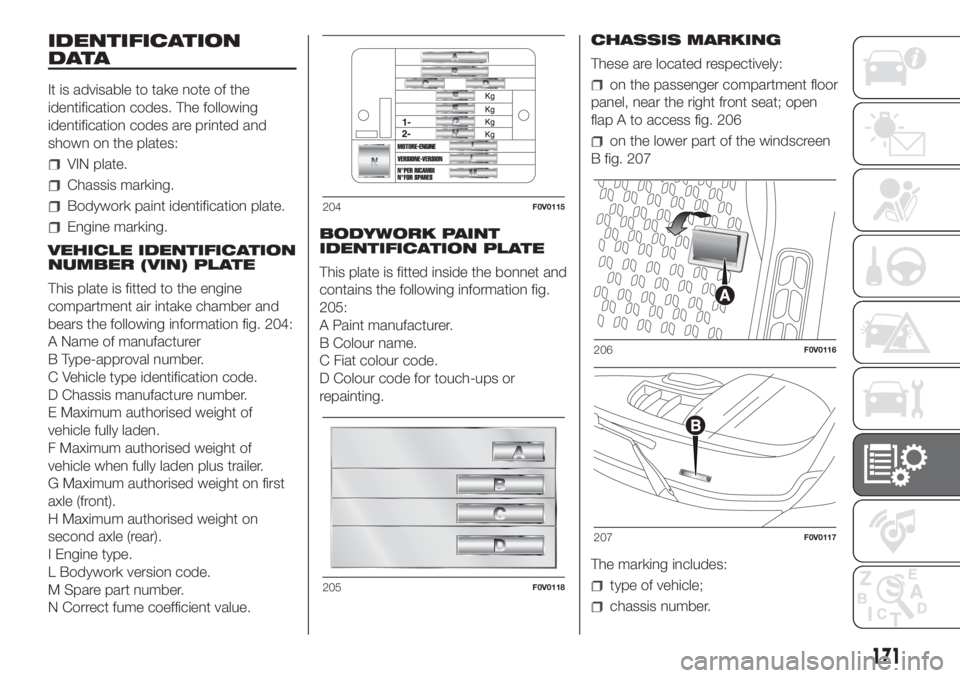
IDENTIFICATION
DATA
It is advisable to take note of the
identification codes. The following
identification codes are printed and
shown on the plates:
VIN plate.
Chassis marking.
Bodywork paint identification plate.
Engine marking.
VEHICLE IDENTIFICATION
NUMBER (VIN) PLATE
This plate is fitted to the engine
compartment air intake chamber and
bears the following information fig. 204:
A Name of manufacturer
B Type-approval number.
C Vehicle type identification code.
D Chassis manufacture number.
E Maximum authorised weight of
vehicle fully laden.
F Maximum authorised weight of
vehicle when fully laden plus trailer.
G Maximum authorised weight on first
axle (front).
H Maximum authorised weight on
second axle (rear).
I Engine type.
L Bodywork version code.
M Spare part number.
N Correct fume coefficient value.BODYWORK PAINT
IDENTIFICATION PLATE
This plate is fitted inside the bonnet and
contains the following information fig.
205:
A Paint manufacturer.
B Colour name.
C Fiat colour code.
D Colour code for touch-ups or
repainting.CHASSIS MARKING
These are located respectively:
on the passenger compartment floor
panel, near the right front seat; open
flap A to access fig. 206
on the lower part of the windscreen
B fig. 207
The marking includes:
type of vehicle;
chassis number.
204F0V0115
205F0V0118
206F0V0116
207F0V0117
171